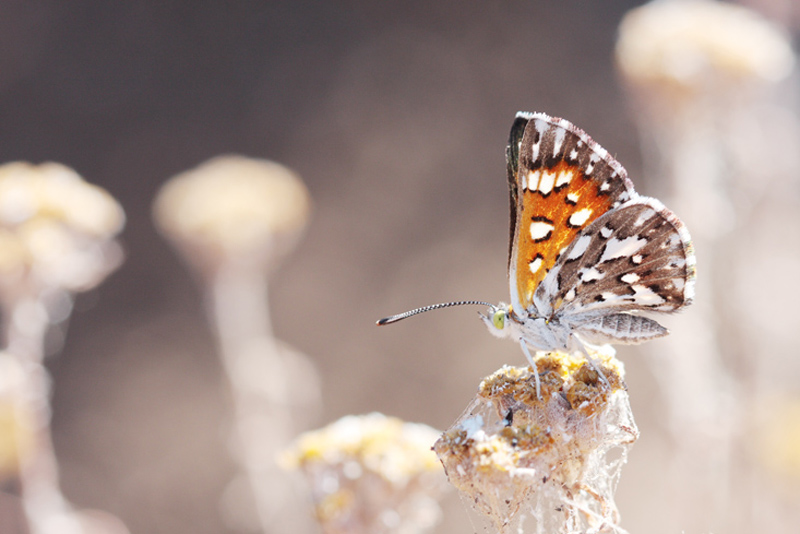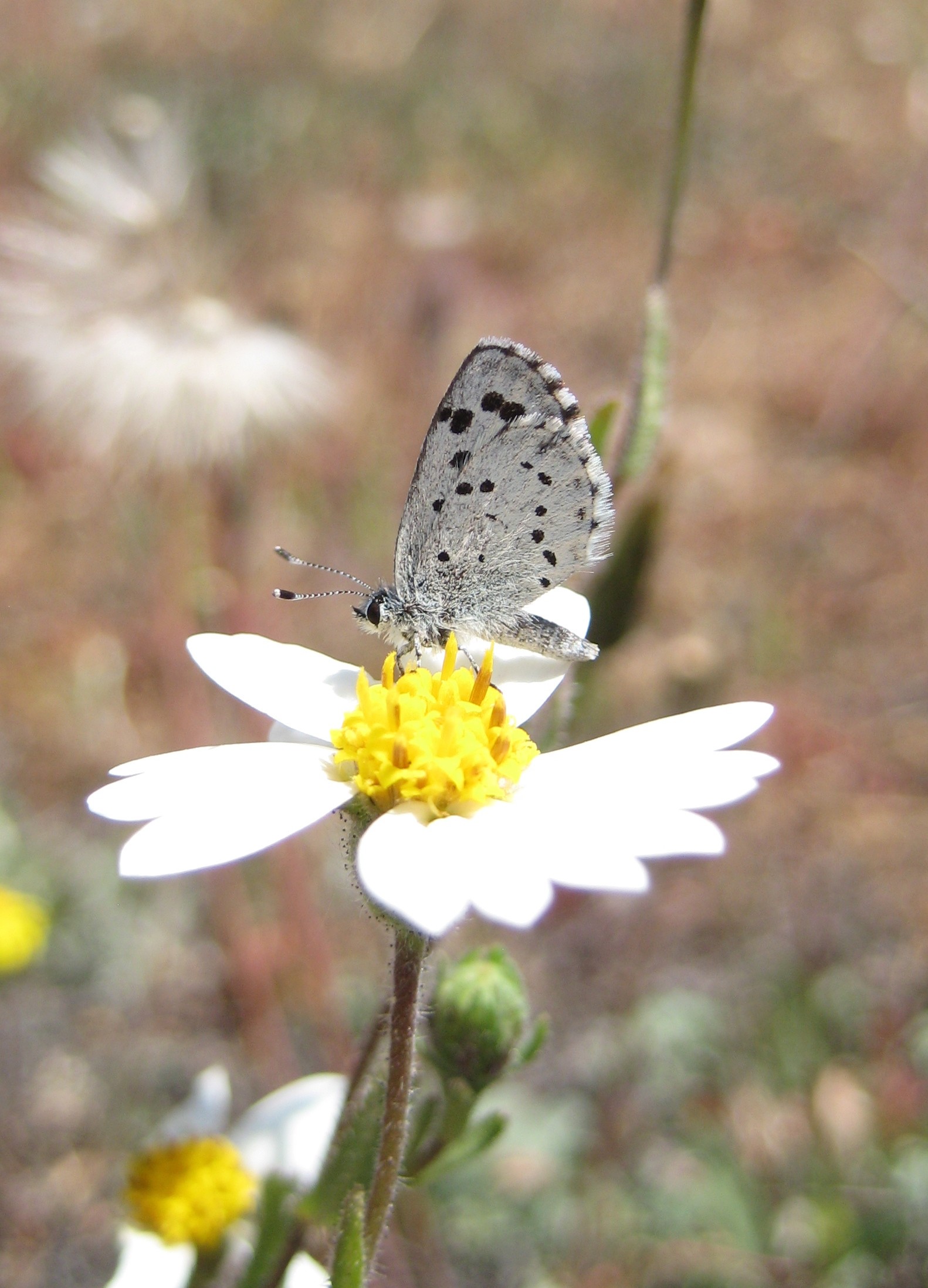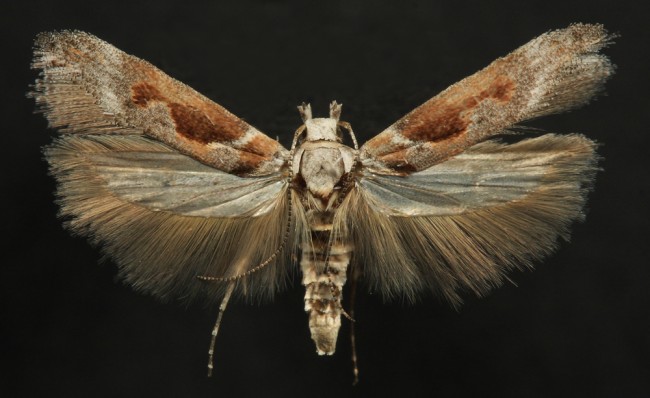Chris Grinter, 24. veebruaril, 2010

Tea seda liblikas? See on OK, keegi tõesti ei. See on perekonna Apodemia (Riodinidae), kuid taksonoomia Selles grupis on katastroof… ja ei hakkagi on alamliigi. See isend pildistatud septembris, mis tähendab, see on kõige tõenäolisem, et olla Apodemia mormo (Mormo) based on flight time. A. Mormo is a fall flyer and A. virgulti is a spring flyer. While some forms seem distinctive, there is massive morphological overlap and they are usually identical and sympatric – actually down to living on the same plants. But according to lab experiments it is impossible to get the pupae to break diapause so they remain reproductively isolated. So are they different? While molecular work is being conducted the verdict is out, but it does seem like these two species may be retained in the end. Ja muidugi, each mountain range has it’s own subspecies. Who knows, I sure don’t. I’m glad I don’t work on butterflies.
Species concepts are a fuzzy line and it’s never clear exactly where to make the cut. When asked what a species is most people default to the Mayr concept of Biological Species (BSC), where reproductive isolation = new. This is all well and good but we have to keep in mind that this is not the ONLY species concept. On dozens, and not one is perfect. Groups like Grammia (Noctuidae: Arctiinae) exhibit high levels of hybridization, which does not adhere well to the BSC. I like to apply as many criteria as possible to delimit a species and it seems like the line is all too commonly thin within insects. I like to see a distinguishing morphological trait, if not in wing color or pattern, at the least in the genitalia or antennae. This is not always the case however and you have to look at the biology and/or DNA. I have looked at two insects that are for all intents and purposes identical. But the biology is radically different and a large % difference (over 8% – jah, arbitrary) in their DNA makes it unquestionable that they are separate.
And if species weren’t contentious enough subspecies stir the pot even more. I’m skeptical about the entire concept, but there are cases in which it seems plausible and necessary. A subspecies is a more formal definition of a geographical “vorm” and usually exhibits a blend zone into another subspecies. For instance if you look at the 27 different populations of Plebejus icarioides there are large differences between northern and southern populations, but very subtile difference along the gradient. It is that persistent gradient that creates one dynamic species instead of 27 separate species – at least according to current research. Moths have been lucky and have thus far avoided the plague of over-subspeciation, butterflies not so much. There may even be instances where greedy collectors have named new subspecies of Parnassius for profit (new rare butterfly subspecies sell for big bucks).
The truth is that species concepts are artificial, poorly understood and dynamic at best; at worst it approaches a soft science with no real possibility of proof. Yet species are real and theories will continue to adapt while we sit here and scratch our heads.
Chris Grinter, 23. veebruaril, 2010 

Üks perks olemise entomoloog reisib ja nõutakse. Panin paar tuhat miili auto igal suvel ja need on kaks parimaid kohti Arizona koguda. Ülemine pilt on pärit Baboquivari Mountains (Baboquivari Peak keskel), Brown Canyon Research Station. The bottom image is of Pena Blanca Canyon, a famous collecting hotspot. This canyon is just 5 miles from Mexico and has a few safety concerns because of our current immigration policy. One morning, while sorting moths from the previous nights catch, a colleague and I had a group of roughly 30 illegals walk right through our camp. They were well dressed and clean, waved, and must have just been dropped off at the fence. Thankfully the majority of illegals are hard-working and honest people trying to earn a better life. It’s the coyotes and smugglers that are scarier – I have heard tales of Mexican police escorting drug caravans into the US with heavy artillery. And just last year a border patrol agent was stabbed to death by a coyote in this vicinity.
Õnneks, a bunch of strange guys standing around strange lights at nights grants us a wide berth.
(Are these images small enough to load quickly?)
Chris Grinter, 23. veebruaril, 2010 Vaatamata sellele, et ta ei tunne liblikatest suurt huvi, neid on ilus vaadata. Siin on tõesti suurepärane video mehelt, keda ma tunnen Lõuna-CA-s. Tema aeglustatud videod liblikõieliste elutsüklitest on üsna muljetavaldavad, ja see on eriti ilus. Kui lõikad umbes 3:00 aastal, näete kümneid suurepäraseid lillasid juukselõike (Atlides halesus) nende krüsaalidest esile kerkivad, värvid on vapustavad. See liblikas on pärit SW-st ja Mehhikost, ja pean tunnistama, et mulle meeldib seda põllult leida.
[youtube=http://www.youtube.com/watch?v=KyWJlpIchkE]
Chris Grinter, 23. veebruaril, 2010 Lühike kommentaar Linus Pauling ja vitamiin C allpool meenus mulle see video esimene postitatud aega tagasi Pharyngula. See on Kary Mullis, leiutaja PCR, ja Nobeli preemia laureaat. Tema leiutis põhiliselt tehtud DNA analüüs võimalik. Aga nagu Pauling, ta on ka täiesti ja täiesti pähklid. Kui teil on aega, et kuulata teda heietama, proovin. Aga lühidalt, Ta arutleb astroloogia, eitab globaalset soojenemist ja kuidas AIDS ei ole põhjustatud HIV. Ma ei tea, mida statistika on geenius teadlased, et libiseks oma jalas?
[Vimeo 9167379]
Chris Grinter, kohta 22. veebruar, 2010 
This is an old image of mine, so it’s not perfect. If you can tell me this butterfly to species you get a high-five. If you know the subspecies, I’ll send you a new pack of #3 stainless steel pins! Only hint: It’s from the western USA.
Chris Grinter, kohta 22. veebruar, 2010 Today I found see article in NY times health – toutingkasu nõelravi kasutatakse depressiooni leevendamiseks rasedatel. Mul on mõned probleemid ajakirjanik, Shirley S. Raha, ei suuda endiselt skeptiline tema tükk. Aga see ei ole üllatav,, so I won’t bother to point out obvious flaws in the media.
I will point out the flaws in the study. Please find the original full text, siin. So after reading this paper I have come to a few conclusions.
1) Very small sample size of 150 patients, ainult 141 treated.
2) The study is blinded ONLY for the depression scoring, not administration of acupuncture. In fact, their release form states “Participants in one of these two groups will receive acupuncture that focuses on depression symptoms and the other treatment will not.” Makes sense, getting a needle shoved in your skin is easy to notice. Nii, these “randomized and blinded” participants knew what was coming and assumed that any poking was supposed to help their depression. Peale selle, see (much better) study has shown that simulated acupuncture with toothpicks works just the same. Careful, this is compelling evidence against the validity of acupuncture – not evidence for the usefulness of stimulated “pressure points”. It is a placebo effect.
3) Study assumes validity of “depression specific” ja “non-specific” acupuncture. Meaning one method of pin sticking somehow cures depression over another. What is this based on? Oh wait, they say exactly the exhaustive scientific evidence right here: “patterns of disharmony according to the principles of traditional Chinese medicine”. I’m sorry, please, give me modern medicine over 2,000 year old mythical beliefs. How was the average quality of life and life expectancy for an ancient chinese person? Pretty damn horrible, and I’m sure the average life expectancy did not exceed 35 aastat.
4) Basing depression scores on one administration of the DSM-IV Hamilton Rating Scale. Not being a psychiatrist I can’t speak to the efficacy of these tests. Kuid, I will go out on a limb and assume that a stronger baseline for depression should be established before comparing results. The test may be accurate, but why not administer it more than once to reduce noise.
5) Selection of massage as a second control. This is a bad attempt at token skepticism, they even state right off the bat “Massage was conceptualized as a control treatment because, although it improves mood immediately after a session, there is insufficient evidence to support its efficacy as a treatment for depression.” When I design a study I like to look at all known factors that I believe will disprove my hypothesis. Choosing something that you already believe will fail only shows their hand of gross bias.
6) Failure to control for socioeconomic factors. 67% of the participants were white, the majority of which were well-educated. They even go as far as to state in the discussion “Therefore, results might not generalize to specific minority groups that were underrepresented in our sample”. Is it just me, or does this statement negate the entirety of their research? They are freely admitting that acupuncture might not work as well in other minority groups. Why could this be? The only logical and scientific answer is that a placebo effect differs across socioeconomic boundaries. If, after all, acupuncture was a legitimate medical science, there would be an insignificant difference seen across physiologically identical organisms.
This study is appallingly bad science. These researchers are beginning with the premise that acupuncture works, and searching for data to support their claims. This is exactly opposite of how to conduct real science. Ja, our health reporter at the NY Times didn’t even bat an eye. Fail for you Mrs. Raha, and fail to the NY Times.
Chris Grinter, 21. veebruaril, 2010 Ma armastan Ming Tsai ja tema cooking impeeriumi nii palju kui järgmise 3-am televaataja. Tegelikult, tema retseptid on fantastiline ja sa peaksid teha neid ise. Aga olen märganud, veider kalduvus teda öelda (parafraseeris) “siis tuleb alati kasutada orgaanilisi, see on palju parem teile”. See jätab mind natuke hämmingus. Mida ta tahab öelda? Ming on haritud ja see ei ole midagi, et ta peaks olema ainuisikuliselt vastutav, kuid ta kordab liigagi levinud väärarusaam, et orgaaniline on tegelikult parem. Parem olen tõlgendades seda tervislikum, mis tundub olevat loogiliselt ületada. Nii, Vaatame andmeid.
Viimastel ja põhjalik ülevaade avaldatakse American Journal of Clinical Nutrition on suures veenis mind, mida ma olin alati skeptiline; et orgaaniline toit ei ole tegelikult tervislikum teile. Nende jaotus need aktid 55 uuringud ja jõudis järeldusele, et “puuduvad tõendid vahe toiteväärtuses vahel orgaaniliselt ja tavapäraselt toodetud toidu”.
Mis siis on kahju? Minu probleem on see kõik, et see põhineb naturalistlik eksitus, et “loomulik” või “orgaaniliste” kuidagi tähendab, et toode on ohutum või tervislikumaks. Mitu korda sa näed perspektiivis “loomulik” poest ja anna kunagi teise mõtte? Kui looduslikud asjad tegelikult olid ohutum siis traditsiooniline Ayurveda ravimeid ei oleks kohutavalt mürgine. Afterall, arseeni, plii ja elavhõbe on looduslikud – kuid nad on ka mõned kõige toksilised ühendid tuntud inimesele. Lõpuks on 100% turundus.
Võtta teise nurga alt Ming Tsai ei pruugi olla kõik, mis vale afterall. Ma ei ole kõiki andmeid, minu ees seoses pestitsiidide toiduainete saastumise, kuid see on loogiline eeldada, vähem saastatud parem. Ilmselt pestitsiidid võivad olla halb, on mägedes kirjandus toetada kahjud, mis võivad põhjustada. Kuid žürii paistab välja, kui halvas, kui üldse, Nende minut jäägid meie toidud on. Tavapäraselt kasvatatud toit on reguleeritud taset jääkide, kuid isegi orgaanika ei ole vabad pestitsiididega saastumine. Nii et ma vaatan seda erinevalt. Meie keskkonnas saab kasu võttes ohutuma toidu nimel. Vähem kemikaale dumpinguhinnaga meie veeteedel, põllumajandustootjad peavad võitlema vähem uskumatult võimas toksiinid, ja blinky kala võitleb näha teine päev. Me kõik peaksime püüdma elada säästlikult ja mahepõllumajandus ei anna meile serv.
Nii et taas, Milline on kahju? Inimesed, kes ostavad orgaanilised üsna tõenäoliselt ei nii rajanema tõelisel keskkonnahooldusega. Tahan ka väita, et väga suur osa neist inimestest usuvad ka need toidud on tervemad (keegi on uuringu andmed selle väite?). Nii et antud juhul on tulemus net positiivne. Kuid, on õigus valedel põhjustel ei tohiks kunagi olla aktsepteeritav. See lööb tipus suurem probleem, mis on ajendatud turundus ja null teadus. Asjas – C-vitamiin külm õiguskaitsevahendile. Uuring PLOS meditsiin on näidanud, ei ole näidustus efektiivsust identne koodidega VITC vastu nohu. Go näitaja, kunagi uskunud, et olla tõsi klammerdada hakanud hakkasid peale teaduse ja andmed. Olgem ettevaatlikud, mida bandwagon me hüpata ja miks.
Chris Grinter, 21. veebruaril, 2010 [youtube=http://www.youtube.com/watch?v=zSgiXGELjbc]
Ma tõesti naudin seda automaatselt häälestatud Saganit, teeb mind koos ma olin nii kõnekas. Vaadake rohkem videoid siit Teaduse sümfoonia.
Chris Grinter, 21. veebruaril, 2010  Nii, how do I begin a new blog? Tough question, but perhaps this is a good time to show off a fun new species. This moth was collected last year outside of Santa Barbara, CA. The massive wingspan, at 15mm, makes it pretty large for a Gelechiid moth. The genus, Gnorimoschema (pronounced nor-a-mosh-ma), seems to be far more species rich than is currently known, so this creature comes as no surprise. It also gives me a chance to brag about the benefits of studying such a wonderfully diverse group of animals. If you happen to be lucky enough to be a friend of mine you’ll probably get your own species at some point. Nii, how do I begin a new blog? Tough question, but perhaps this is a good time to show off a fun new species. This moth was collected last year outside of Santa Barbara, CA. The massive wingspan, at 15mm, makes it pretty large for a Gelechiid moth. The genus, Gnorimoschema (pronounced nor-a-mosh-ma), seems to be far more species rich than is currently known, so this creature comes as no surprise. It also gives me a chance to brag about the benefits of studying such a wonderfully diverse group of animals. If you happen to be lucky enough to be a friend of mine you’ll probably get your own species at some point.
Teiselt poolt, this also highlights the problem – knowing almost nothing about the most diverse group of animals on our planet. What happens when a new crop is being eaten by a tiny, nondescript, ööliblikas? Call one of the dozen people in the world who might be able to help you. Maybe they know what it is, but likely nothing is known about its biology. This is what happened in South Dakota recently when biofuel crops were being eaten by a moth last seen in 1910. What a perfect reason for more funding! More likely than not my new moth above will never explode into a pest. But having basic knowledge of the species that share this earth with us is a step in the right direction.
|
Skeptitsism
|





